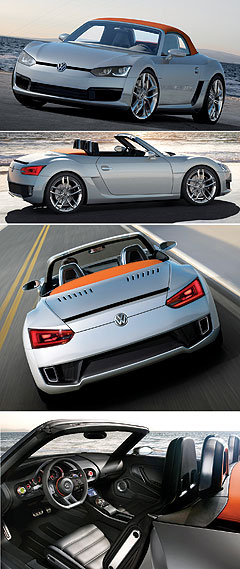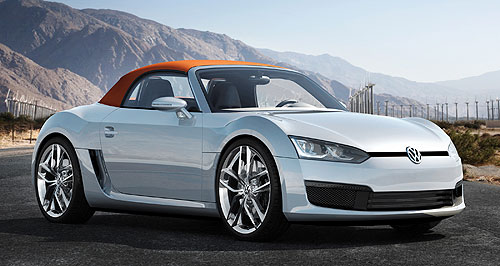Future models - Porsche - Compact sportscarPorsche holds tight on product reinsCandidate: Porsche is thought to be considering its own version of Volkswagen's mid-engined BlueSport roadster concept. Shared models not a problem, as long as we lead development, says Porsche13 Nov 2009 PORSCHE says that as part of its stated global goal to sell 150,000 vehicles a year it will share vehicle platforms with new parent company Volkswagen only if it leads the development program. Volkswagen chief Martin Winterkorn triggered a wave of speculation about which VW models Porsche could redevelop for itself when he recently confirmed Porsche was expected to double its global sales rate of about 75,000 this year by as early as 2012. However, Porsche Cars Australia Michael Winkler points out that target was already nominated by the company before Volkswagen’s takeover, first by ousted Porsche head Dr Wendelin Wiedeking and more recently by his successor Michael Macht. Speaking at last week’s 911 GT3 launch, Mr Winkler said additional models would be required to reach 150,000 worldwide sales a year, including more than 1500 in Australia. “Globally we do envisage to be at some stage in the future at 150,000 sales annually, and that can only happen if we have additional model ranges,” he said. “But we will only share platforms with Volkswagen if we lead the development.”  While Mr Winkler would not elaborate on which VW platforms could be developed by Porsche, the number one candidate is believed to be a Porsche version of Volkswagen’s mid-engined BlueSport roadster concept, which is yet to enter production but could already be under development at Weissach. While Mr Winkler would not elaborate on which VW platforms could be developed by Porsche, the number one candidate is believed to be a Porsche version of Volkswagen’s mid-engined BlueSport roadster concept, which is yet to enter production but could already be under development at Weissach.While an entry-level four-cylinder Boxster and further body style derivatives of the new Panamera sedan (including coupe and convertible versions) are also likely, Porsche’s second extra model line could employ the same compact SUV platform as Volkswagen’s Tiguan or Audi’s Q5. If Porsche holds sway and leads the development of any shared future models, a smaller sibling for the Cayenne could also form the basis of the next-generation Tiguan and/or Q5. Despite the fact it has registered the Roxster name, Porsche has as recently as May 2007 denied it will develop a mid-size luxury SUV to be positioned beneath the Cayenne. That was before Mr Winterkorn referred in August to a “little brother” for the Cayenne, as well as “a vehicle under Porsche’s smallest model to date, the Boxster”, as part of a renewed push towards 150,000 vehicles a year “in the foreseeable future, say 2012 or 2013”. Now under Volkswagen ownership, Porsche will again share the basis of next year’s second-generation Cayenne with that of the VW Touareg and Audi Q7. This time, however, Porsche hopes VW will not jump the gun by allowing its all-new luxury SUV to hit the market first. Porsche had been on track to record 100,000 global sales a year before the automotive industry slump hit in 2008, after which the company’s Australian sales also plummeted. Mr Winkler said PCA would sell about 1000 cars this year – down from a 2007 high of 1380 and last year’s tally of 1157 – but he is adamant Australia is good for annual Porsche sales of at least 1500 beyond the global financial crisis. “In an improved business environment, I don’t see any reason why we can’t sustain 1500 to 1700 sales a year in Australia, but the general business environment has to return to where it was a year or two years ago,” he said. Porsche sales in the first 10 months of 2009 are down 16.2 per cent on 2008 levels at 888 vehicles, with the 911 leading the decline by being down 44 per cent, the Boxster next worse at 23.2 per cent, the Cayman coupe down 16.7 per cent and the Cayenne down by 3.8 per cent – and holding its market share. However, Mr Winkler said that addressing tightening profit margins and slipping residual values was more important than increasing sales in 2010. “I don’t want to grow again yet,” he said candidly. “I’d rather work on resale values and dealer margins before we pump more cars out. In order to have profitable growth I’ve got to have a healthy dealer network.” Mr Winkler said the key to increasing the profitability of his dealer network was to demonstrate the sales potential of current and future Porsche models. “The dealer network that we have today is only two more than we had eight years ago with just two models – 911 and Boxster,” he said. “So we haven’t increased the number of dealers we have but we have put some very stringent investment requirements in place. So the cost of business certainly is higher than it was eight years ago, but the cost of business hasn’t grown as incrementally the same as the volume has, so with 1000-1100 cars a year we’re still in a very healthy position as far as the dealer network is concerned. “As to whether they can service the investments they have made … perhaps they’re not going to earn the return on the investment that they should, but simply service them. “Our job is to give them a return going forward in order to give them incentive to invest, by showing them that we are capable of doing much better than we are currently.” Mr Winkler said he expected total industry sales volume to remain at about 900,000 vehicles next year, when he forecast margins to remain slim. “The volume will be there (in 2010),” he said. “(But) It will be a highly subsidised market. Nobody admits to subsidising sales but nobody will be making money.” The long-serving local Porsche chief said no discussions had been held about potential changes in distribution arrangements for Porsche in Australia, and is convinced Volkswagen ownership will be good for the Zuffenhausen brand. “At the end of the day the industrial logic was that we wanted a very strong partner and Volkswagen was the logical partner going into the future, particularly from and R&D sharing point of view,” he said. “Irrespective of the path that it took to get there that is the outcome for us and it’s very positive. “The heads of agreement between the parties at this stage very clearly stipulates that Porsche stays an independent company. Our job is to develop interesting cars … our job is to produce them and to sell and service them. “At year end our job is to provide a dividend cheque to our shareholders and nothing has changed.”  Read more24th of August 2009  Porsche Roxster lives againPorsche to resurrect sub-Cayenne SUV and sub-Boxster sportscar under VW18th of May 2009  Recession pulls reins on mid-engined VWAffordable roadster from Volkswagen waits for better economic timesAll future models Alfa Romeo Alfa Romeo Abarth Abarth Alpine Alpine Alpina Alpina Audi Audi Aston Martin Aston Martin BMW BMW Bentley Bentley Chery Chery Brabham Brabham Chrysler Chrysler Chevrolet Chevrolet Cupra Cupra Citroen Citroen DS DS Dodge Dodge Fiat Fiat Ferrari Ferrari Foton Foton Ford Ford Great Wall Great Wall FPV FPV Haval Haval GWM GWM Honda Honda Holden Holden Hummer Hummer HSV HSV Infiniti Infiniti Hyundai Hyundai Jaguar Jaguar Isuzu Isuzu Kia Kia Jeep Jeep Land Rover Land Rover Lamborghini Lamborghini Lexus Lexus LDV LDV Mahindra Mahindra Lotus Lotus Mazda Mazda Maserati Maserati Mercedes-AMG Mercedes-AMG McLaren McLaren MG MG Mercedes-Benz Mercedes-Benz Mitsubishi Mitsubishi Mini Mini Opel Opel Nissan Nissan Peugeot Peugeot Pagani Pagani Proton Proton Porsche Porsche Renault Renault Ram Ram Rover Rover Rolls-Royce Rolls-Royce Skoda Skoda Saab Saab SsangYong SsangYong Smart Smart Suzuki Suzuki Subaru Subaru Toyota Toyota Tesla Tesla Volvo VolvoMotor industry news |
Click to sharePorsche modelsResearch Porsche All future models Alfa Romeo Alfa Romeo Abarth Abarth Alpine Alpine Alpina Alpina Audi Audi Aston Martin Aston Martin BMW BMW Bentley Bentley Chery Chery Brabham Brabham Chrysler Chrysler Chevrolet Chevrolet Cupra Cupra Citroen Citroen DS DS Dodge Dodge Fiat Fiat Ferrari Ferrari Foton Foton Ford Ford Great Wall Great Wall FPV FPV Haval Haval GWM GWM Honda Honda Holden Holden Hummer Hummer HSV HSV Infiniti Infiniti Hyundai Hyundai Jaguar Jaguar Isuzu Isuzu Kia Kia Jeep Jeep Land Rover Land Rover Lamborghini Lamborghini Lexus Lexus LDV LDV Mahindra Mahindra Lotus Lotus Mazda Mazda Maserati Maserati Mercedes-AMG Mercedes-AMG McLaren McLaren MG MG Mercedes-Benz Mercedes-Benz Mitsubishi Mitsubishi Mini Mini Opel Opel Nissan Nissan Peugeot Peugeot Pagani Pagani Proton Proton Porsche Porsche Renault Renault Ram Ram Rover Rover Rolls-Royce Rolls-Royce Skoda Skoda Saab Saab SsangYong SsangYong Smart Smart Suzuki Suzuki Subaru Subaru Toyota Toyota Tesla Tesla Volvo VolvoMotor industry news |
















Facebook Twitter Instagram